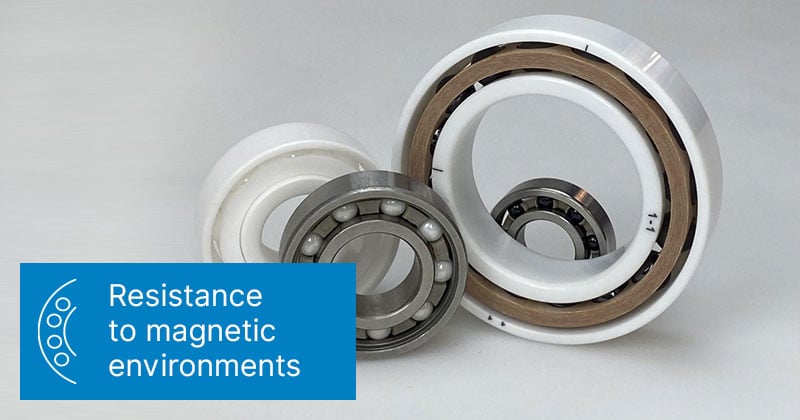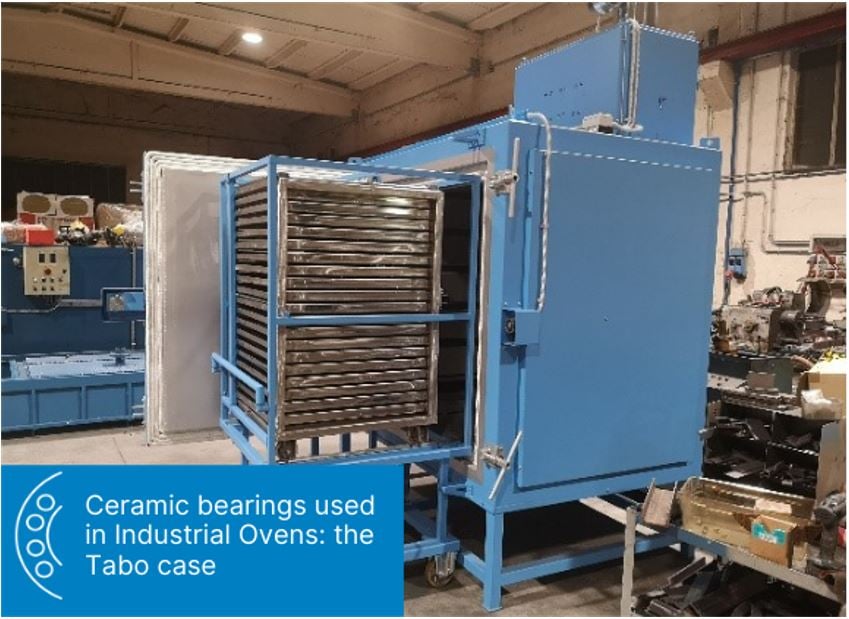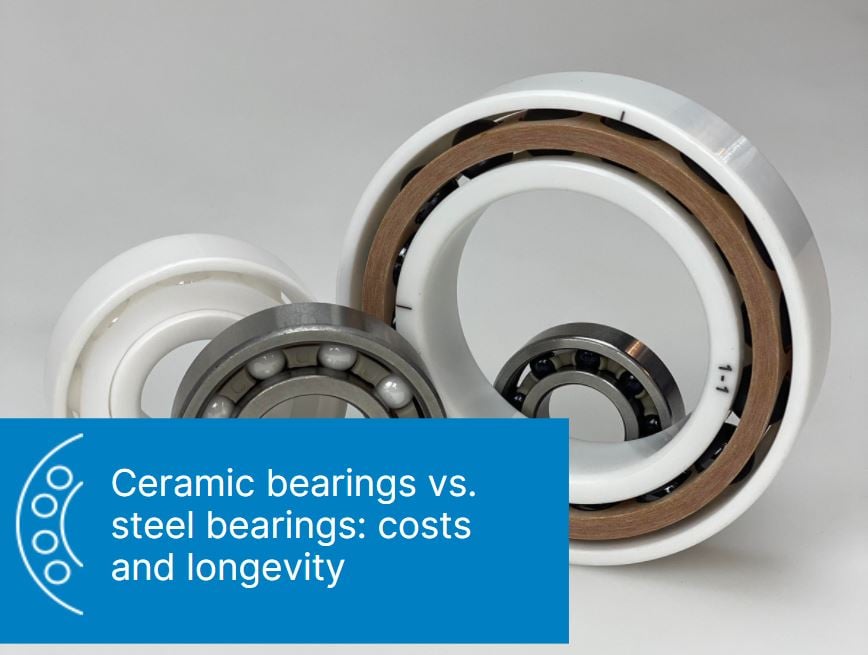
Ceramic bearings can prove to be the winning solution for applications in the presence of magnetic fields. In this article we will discuss the application of the ceramic bearing in case of magnetic fields.
The steels used for almost all the production of rolling bearings belong to two families: special heat-treated steels (such as 100Cr6) and special case-hardening steels (such as 20NiCrMo7).
A bearing made of these steels subjected to magnetic fields can be subject to various forms of damage:
- Magnetic adhesion of particles or residual dirt on tracks and rolling elements that affect the contact surfaces with a consequent increase in vibrations and wear
- Triggering of electric discharges between tracks and rolling elements due to residual currents caused by rotating magnetic fields that increase bearing wear
- Increased temperature and friction due to hysteresis losses due to the inversion of the magnetic polarity, eddy currents due to rotating fields and magnetic attraction forces
- Hydrogen embrittlement which can cause brittle flaking (white etching cracks or white structure flaking) with increased wear of the bearing.
- Possible deterioration of the tribological characteristics of the lubricants used.
It should also be considered that very often the magnetic fields are also associated with electric fields which, by causing eddy currents, accentuate and amplify the negative effects on the bearings.
For these reasons, the choice of a bearing that must be inserted in an environment with magnetic fields and / or electric fields can be difficult and, if it is not done correctly, can lead to the premature and unexpected replacement of the bearing with increase in costs for extraordinary maintenance.
It may seem that there are no effective solutions to this type of problem, but, in reality, the technological advancement of both materials and processing operations provide us with a range of choices within which to find the optimal solution.
The fundamental concept that must always be taken into consideration when choosing the materials with which to make the bearing is the physical principle of the lines of force of the magnetic fields and of the electric fields: if we can interrupt these lines of force, the magnetic field and the electric field they cannot have their negative effect on the bearing.
To interrupt the lines of force of a magnetic field it is necessary to adopt a class of materials called non-magnetic. In the case of the presence of electric fields, however, it is necessary to adopt materials that are electrical insulators.
At the current state of technological development, the non-magnetic or electrical insulating materials that can be used for the production of bearings are the following:
- Austenitic stainless steels (AISI304 and AISI316): they are non-magnetic but not electrical insulators
- Plastic materials such as, for example, PA or PA66, PEEK, PTFE: they are non-magnetic and electrical insulators
- Ceramic materials such as ZrO2, Si3N4, SiC, Al2O3: they are non-magnetic and electrical insulators
Each of these materials has advantages and disadvantages and the choice must be made carefully according to the conditions of use of the bearing.
Austenitic stainless steels such as AISI 304 and AISI 316 are non-magnetic and therefore can be used effectively in the presence of magnetic fields. However, since they are not electrical insulators, if the application also involves the presence of electric fields such as, for example, in electric generators, the bearings made with these materials will suffer the negative effects of eddy currents. Furthermore, these steels are not hardenable and therefore their hardness is decidedly lower than those of the normally used bearing steels. This means that the load carrying capacity of these bearings is very low. The non-hardenability also has a negative effect on the quality of the mechanical processing, so the roughness of the races is higher than that of the standard bearing with a further negative effect on the duration. Ultimately, this type of steels can only be used if the stresses on the bearing are very low. They can be used in chemically aggressive environments, at low or high temperatures and even in the presence of radiation.
The plastic materials that can be used for the production of bearings (PA, PA66, PEEK, PTFE) have non-magnetic characteristics as well as being electrically insulating and therefore can be used for applications even with the simultaneous presence of magnetic fields and electric fields. They are materials that can be relatively inexpensive (with the exception of PEEK) and easily workable. The aspects to be considered in their application concern the load capacity, which can be very low, and the extreme difficulty in having accuracy and clearances comparable with steel bearings.
Ceramic materials are the most performing class of materials for this type of applications and can be used in two types of bearings:
- Hybrid bearings, i.e. with standard steel rings and ceramic rolling elements
- Fully ceramic bearings, i.e. with rings and rolling elements in ceramic material
In hybrid bearings, the presence of rolling bodies in ceramic material allows to interrupt the lines of force of the magnetic field that cross the bearing but there could be other magnetic fields that, passing through the individual rings, cause negative effects. The application must also be carefully studied because it is not always easy to understand the path of the magnetic fields that can form inside some machines or equipment. In terms of load capacity, these bearings have a lower capacity than their steel counterparts but with a higher maximum speed.
The totally ceramic bearings, on the other hand, allow to obviate all the negative effects of magnetic fields or electric fields, maintaining a load capacity at least equal to that of the homologous steel bearings and a maximum speed higher than that of hybrid bearings. Furthermore, they can be used in chemically aggressive environments, in the presence of radiation, with operating temperatures that can reach 1200 ° C and in conditions of scarce or no lubrication.
Would you like some specific advice based on the application? Our best experts are ready to find the right solution, click below to contact them.








